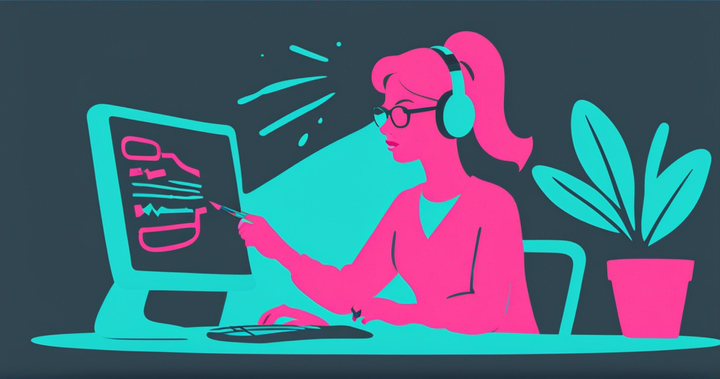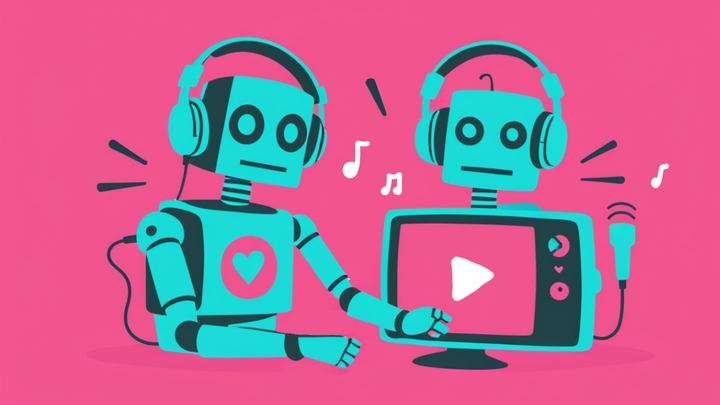5 AI Trends That Are Reshaping Technology
AI has changed everything about technology. Learn about the trends that are shaping these exciting new applications.

AI is the buzzword on everyone’s lips. In the same spaces where we were all talking about the metaverse, cryptocurrency, and NFTs, the cultural conversation has now firmly shifted to artificial intelligence. AI has also made its way into mainstream cultural conversations, everywhere from social media to the SAG-AFTRA member strike.
AI’s meteoric rise in popular culture makes it seem like a trend, but the truth is artificial intelligence has slowly been creeping its way into every facet of everyday life, and it’s not going anywhere anytime soon. It represents our present, but also our future.
Artificial intelligence isn’t particularly new. Its history dates back to mathematician Alan Turing and the first theories about and iterations of AI in the 1940s. These days, you interact with AI all the time — from doing a quick Google search to using a filter on TikTok.
In a nutshell, artificial intelligence is when a machine is able to analyze data, make predictions, and create meaning — mimicking what our brains are able to do. In practical terms, AI lets computers quickly make decisions based on complex inputs, so that we don’t have to. Current AI applications use both machine learning and natural language processing to achieve this.
While AI itself isn’t a trend, there are particular trends within the AI space worth paying attention to if you want to stay ahead of the curve.
Let’s go over five of those trends as well as what they mean for creators and brands.
AI Trend #1: “Everything” Is AI
Ok, so maybe not everything. But you’ve probably noticed that there are AI tools popping up all over the place and every third software you see advertised online is being marketed as AI. What’s up with that?
As interest in artificial intelligence skyrockets, brands (and consumers) are more and more likely to call something AI, even if it’s only partially powered by AI. Just look at Google searches for the term AI over the last five years around the world.
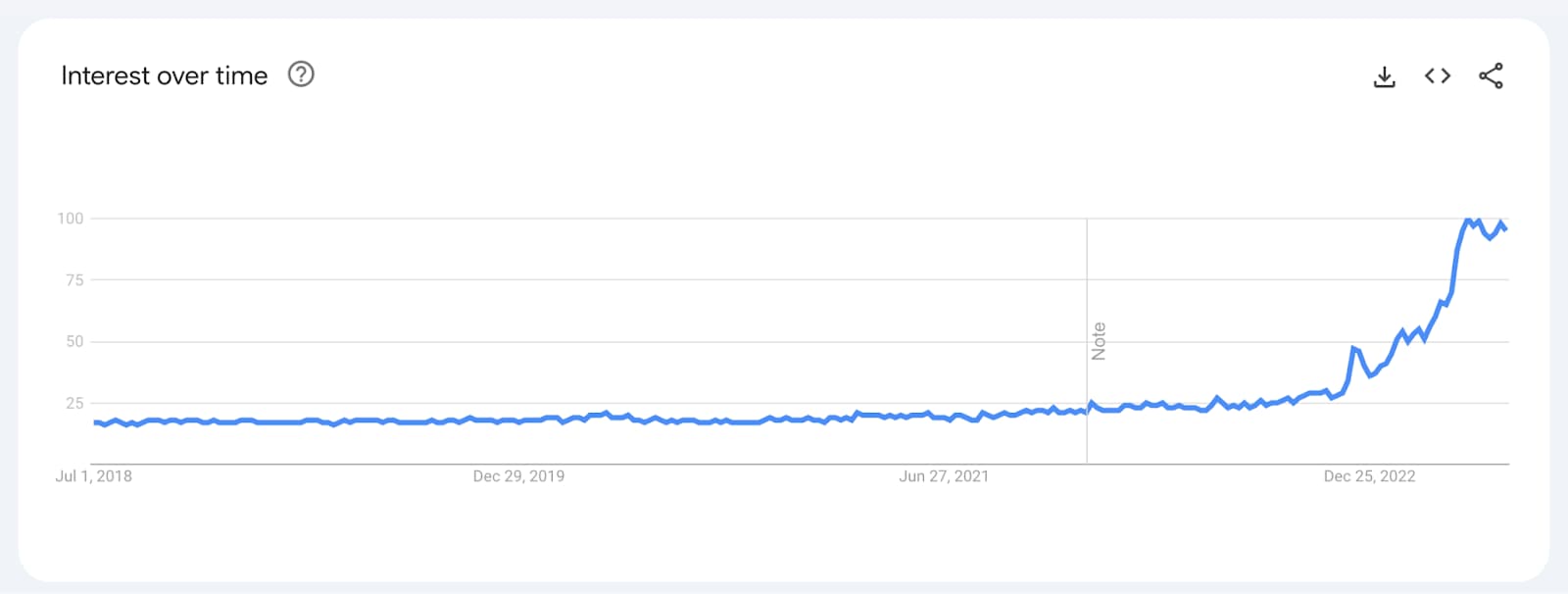
It’s not without reason. The global artificial intelligence market is expected to reach more than $1.8 billion by 2030. In fact, 91% of top businesses in one survey from NewVantage reported an ongoing investment in AI. And, according to IBM, 35% of business organizations said they used AI as part of the business in 2022.
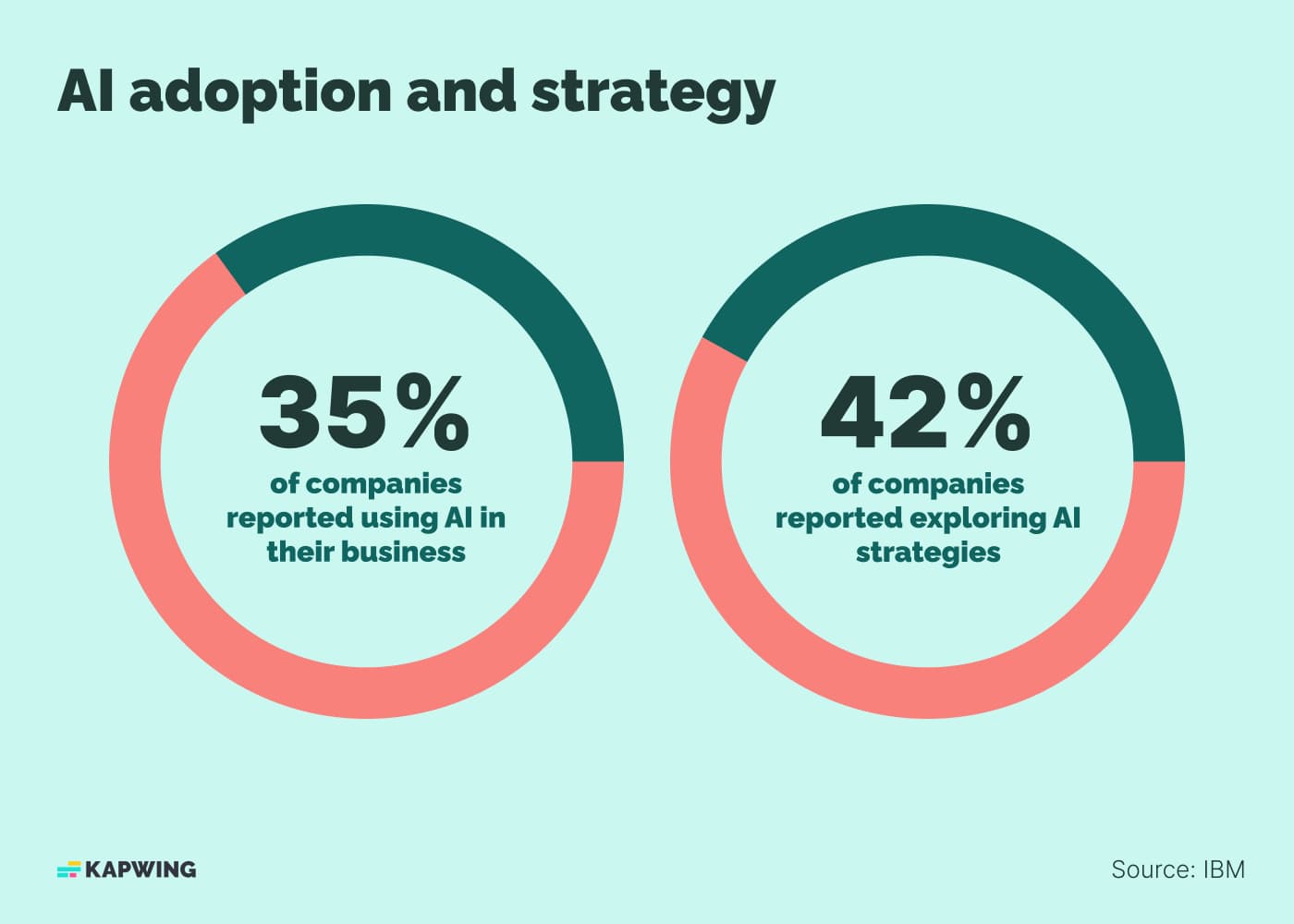
So, yes, the availability and prevalence of AI is growing, but so is our likelihood to actually name when a technology we’re using is powered by artificial intelligence. Calling a spade a spade, if you will.
The truth is, AI has slowly but surely become a key part of many technologies we use, even though we weren’t all shouting about it until recently.
When you lift up your iPhone and it unlocks after scanning your face, that’s AI and machine learning. When Twitter shows you a curated selection of tweets and accounts it hopes you’ll enjoy, that’s AI. When you’re typing an email and it auto suggests the next few words, that’s AI. When you talk to your Alexa, that’s AI.
The level of sophistication varies, of course. You might encounter relatively simple AI applications in day-to-day life, but behind the scenes AI is being used for agriculture, pharmaceutical research, military applications, astronomy, and just about everything else.
Some have even argued that we’re overusing the term AI. In a piece for Inc. magazine, columnist Jason Aten argues that a lot of what we call AI is actually just “computers doing computer stuff.”
However you look at it, the term “AI” has simply become more common. In a Google developer conference, for example, as Aten points out, the words “AI” or “artificial intelligence” were said more than 100 times in a two-hour keynote.
AI Trend #2: Broader Adoption of AI
As a brand or creator, you’re probably most familiar with consumer-facing AI models like ChatGPT, AI art generators, smart assistants like Siri, or AI-powered video editing. But AI systems run deep throughout many industries.
In May 2023, it was found that job listings related to generative AI jumped 20% as more companies tried to capitalize on this technology’s rapid growth. This can, at least in part, be attributed to the sudden and explosive popularity of ChatGPT. It also comes even as demand for tech jobs is down overall.
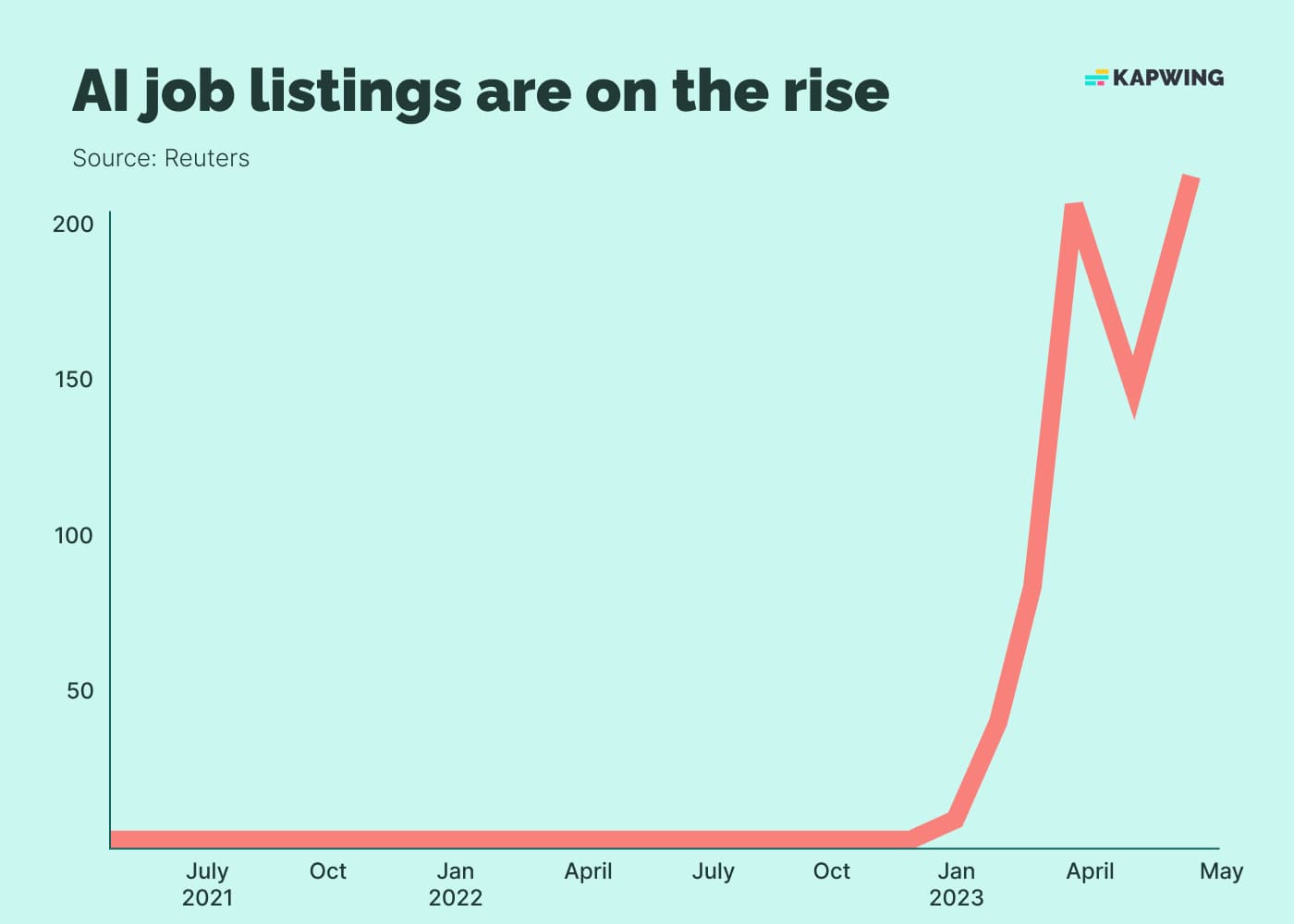
Companies are also eagerly investing in AI technologies. An industry survey found that 44% of private sector companies plan to invest in AI systems in 2023.
Going back to that IBM report, larger companies are more likely to adopt AI than smaller companies, but even small organizations are catching up. In that report, 41% of smaller companies are now developing AI strategies. Across all companies, organizations are 13% more likely to have adopted AI technologies in 2022 compared to 2021.
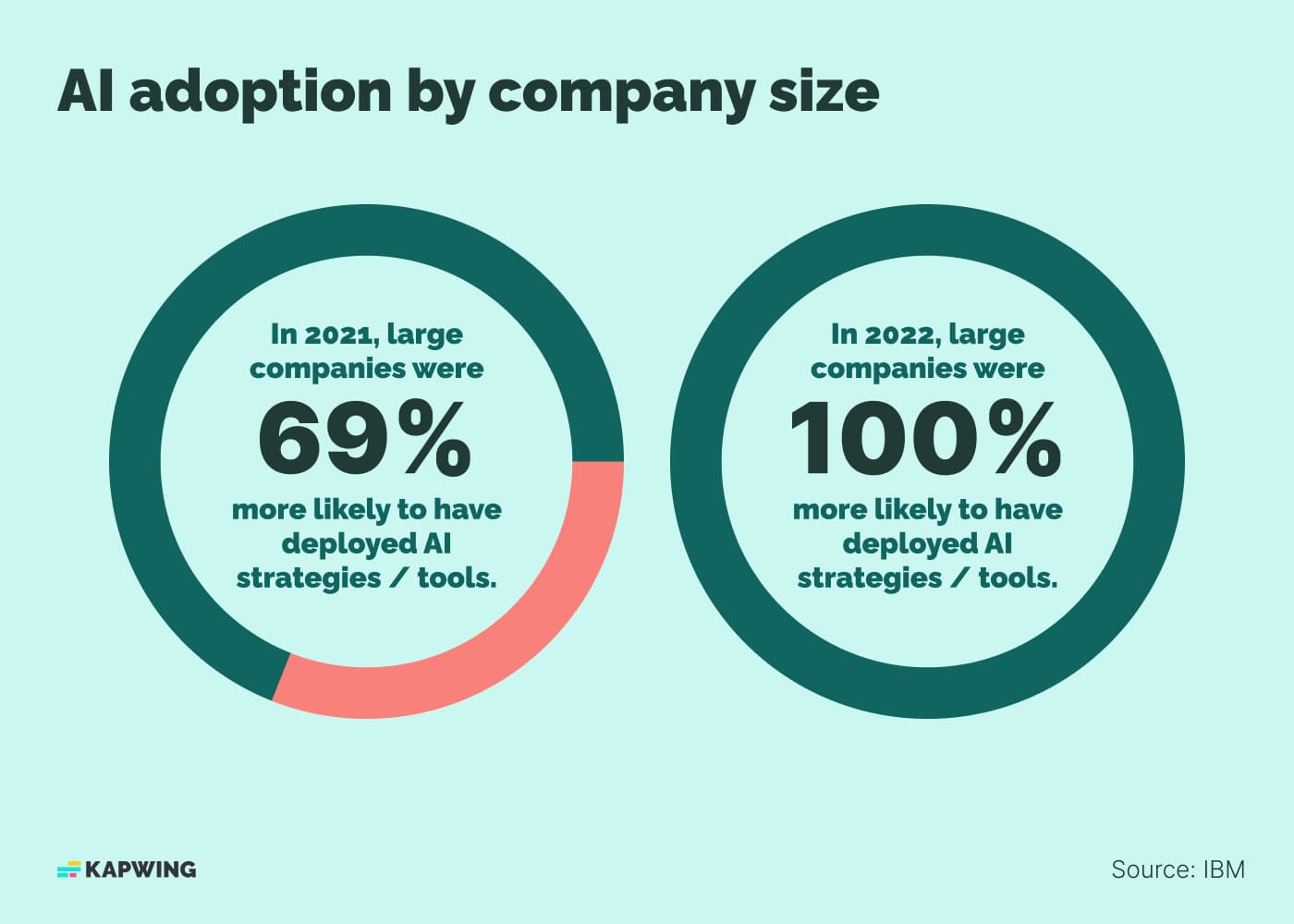
Globally, it should be no surprise that AI exploration and adoption is higher in centers of tech industry, such as China, India, and Singapore, but interest is up across the world.
The natural question is why exactly has interest increased so much? It’s not just that AI is trending, it’s that it’s become more accessible.
The top factors driving AI adoption include advancements that make it easier to access (43%), the need to reduce costs with automation (42%), and the increase in AI being available in off-the-shelf business products (37%). Additionally, IBM found that one in four companies are adopting AI due to labor or skills shortages.
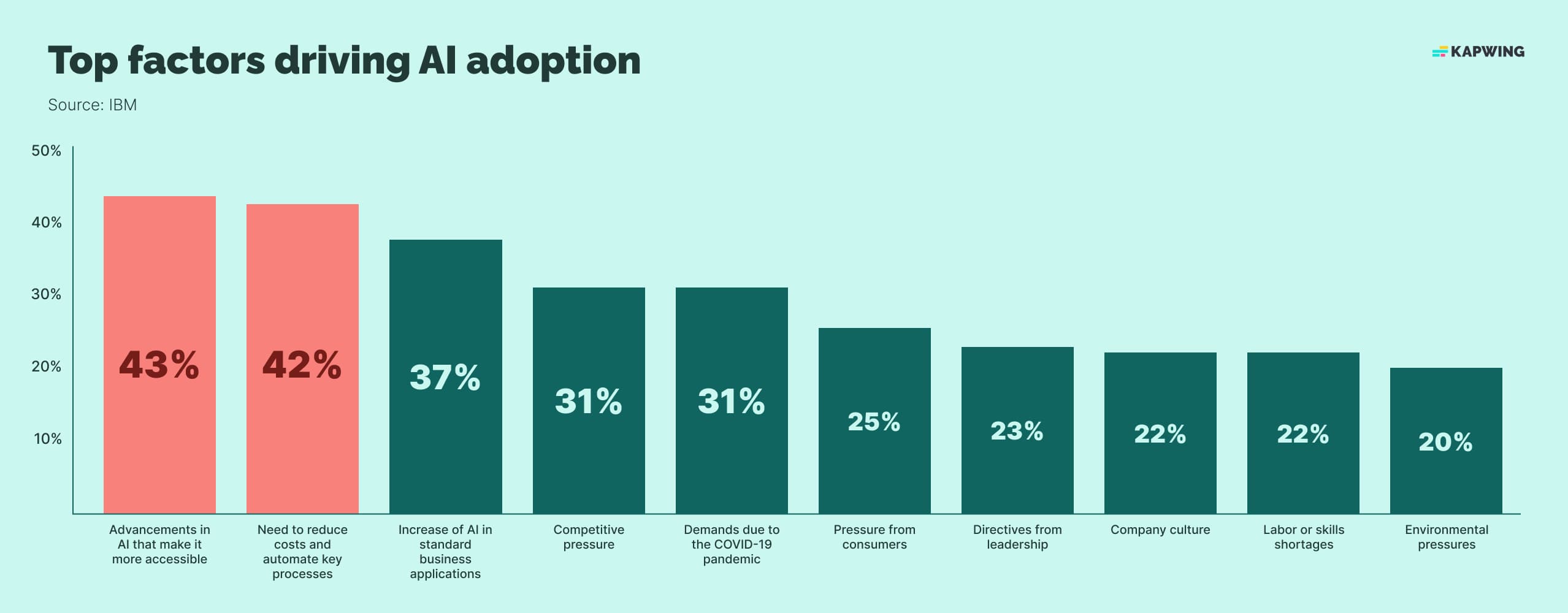
In particular, companies are investing in AI in the areas of research and development, improving current processes, and reskilling their workforce.
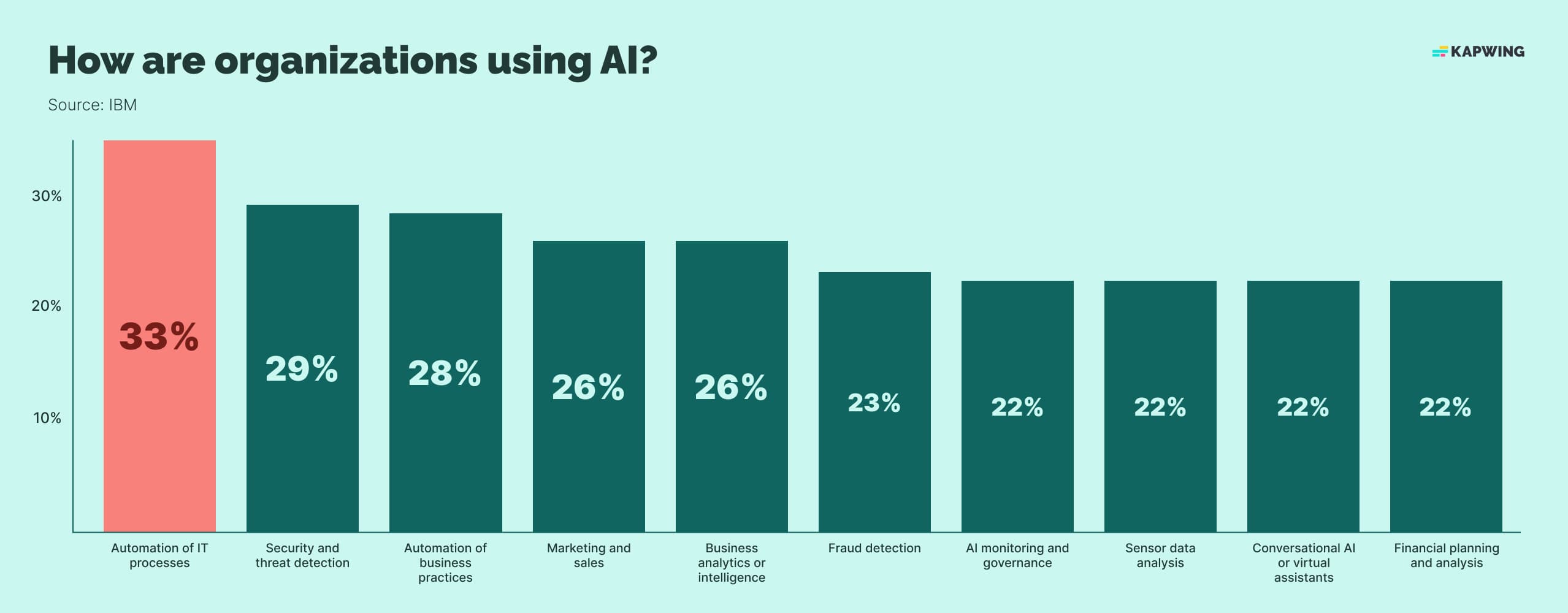
The beauty of AI for industry is that it has the power to automate processes, making day-to-day operations more efficient — and that’s something that every industry wants more of.
Speaking of automating tedious processes…
AI Trend #3: Outsourcing Tedious Tasks to AI
In any space, there are tasks that are repetitive and time-consuming, and AI can make all of that easier.
The current trend in consumer-facing AI is applications that simplify and automate processes. A great example of this is natural language processing chatbot apps such as ChatGPT or Bard by Google. These applications are able to understand full-sentence questions and then scan tons and tons of data to deliver comprehensive answers.
For example, as a creator or brand, you can ask ChatGPT to:
- Generate competitive keywords
- Write social media captions
- Write product descriptions
- Scan and summarize a competitor’s web page
- Write alt text for images
- Write scripts for a video
- Come up with content ideas for social media platforms
- Write a bio
- Generate hashtags
- Write titles for videos
And truly, that’s just scratching the surface. This use of AI is typically generative AI — which is when AI is used to create something completely new. For example, you give ChatGPT a prompt, and it delivers an original piece of text. Or, you ask an AI image generator for a picture of a puppy, and it creates one that’s never been seen before. Generative AI is truly the current frontier of AI.
Tools like ChatGPT really shine in the brainstorming and iteration stage. In this example, we asked ChatGPT for keywords related to “matte liquid lipstick.”
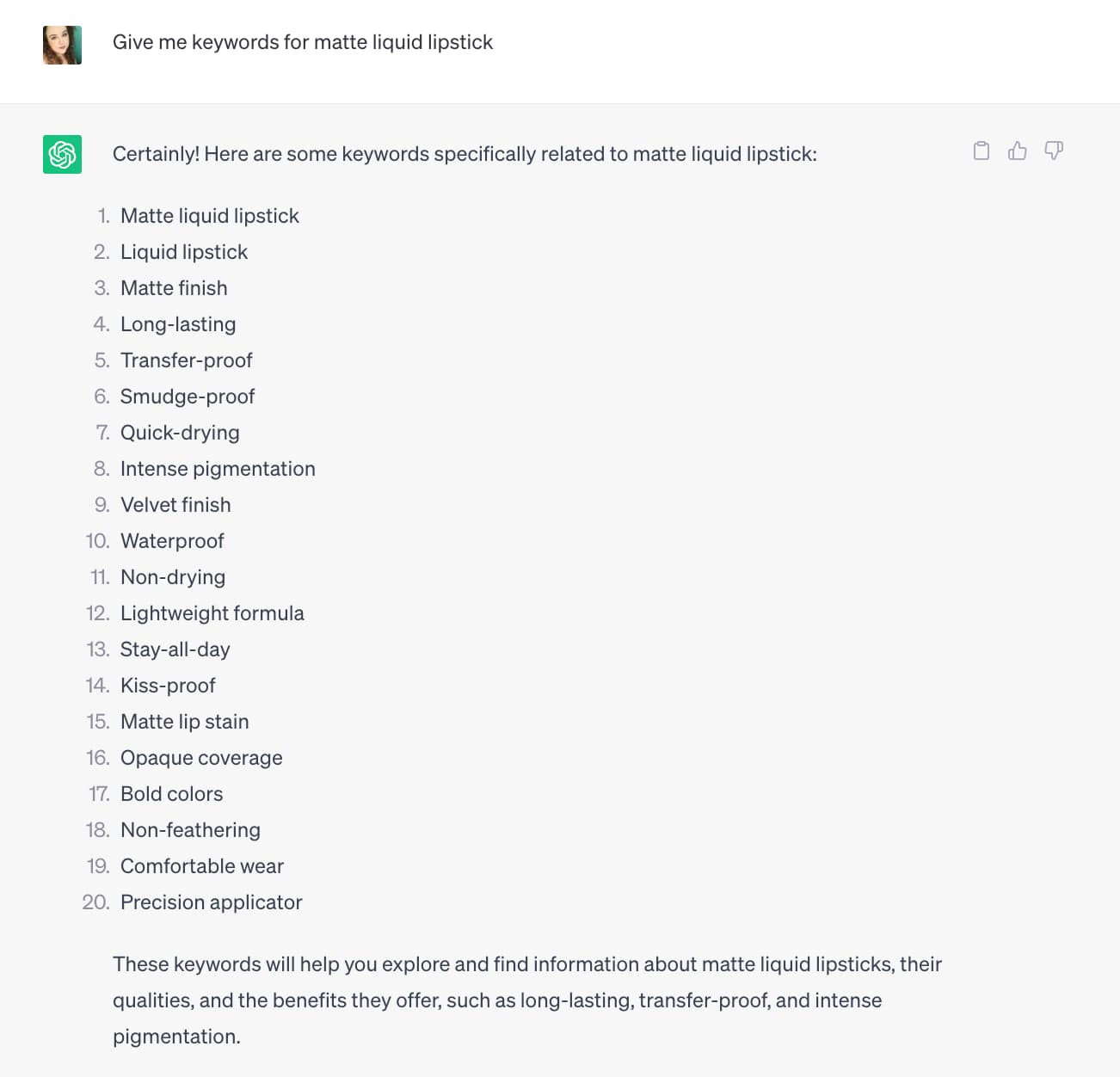
Some of the options it provided for me are obvious, like “liquid lipstick” or “matte finish.” However, it also came up with several semantically related keywords that users looking for a matte liquid lipstick might also be searching for. Like “lightweight formula” and “kiss-proof.”
You could plug this list of keywords into a traditional SEO research tool, like Semrush or Ahrefs, to look at monthly search volume and difficulty ratings, and prioritize accordingly. If you're researching for social media content, use the native search tools on the platform to determine search volume, number of posts, and engagement for the keywords ChatGPT suggests.
In this example, we asked ChatGPT for TikTok ideas about the same product:
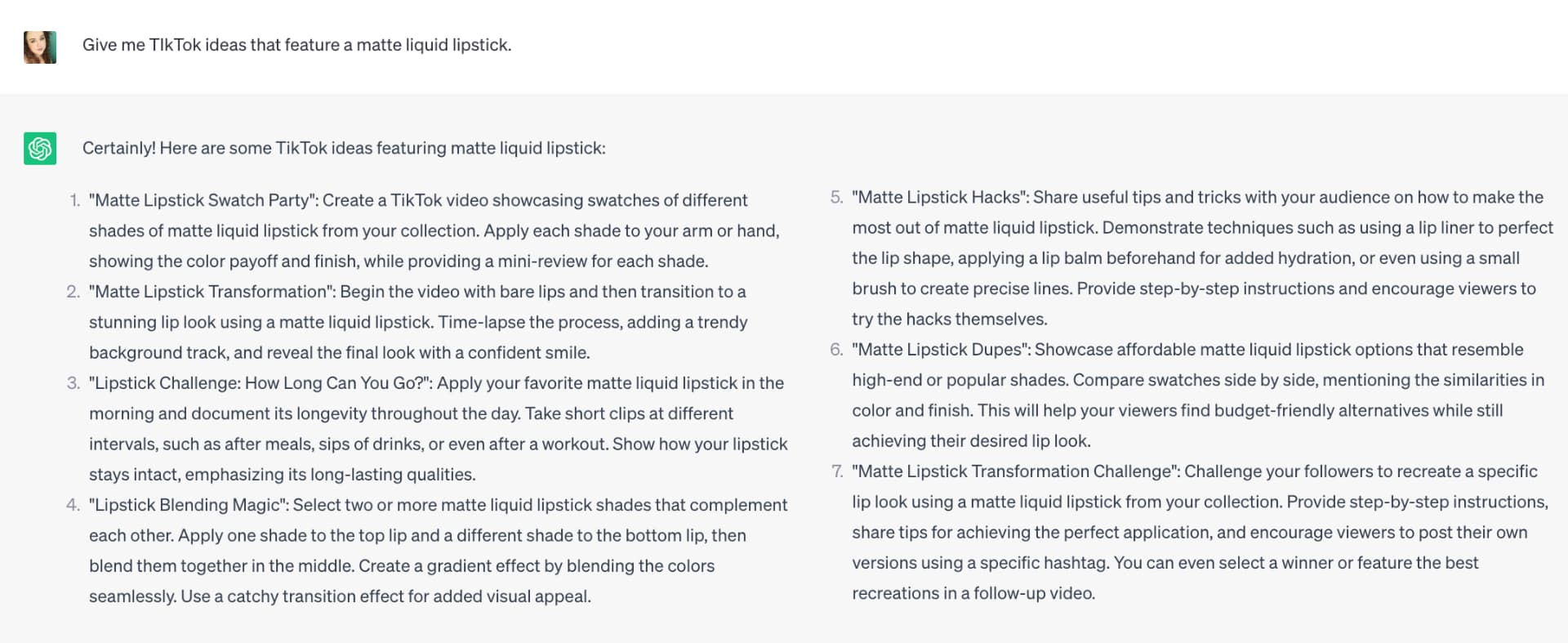
You could create these videos yourself or include them in the creative brief for a UGC or influencer campaign. And whether you dive straight into these ideas or simply use what ChatGPT delivered as inspiration, you’ve already saved a ton of time.
These examples were fairly simple prompts. ChatGPT and applications like it can handle much more complex inputs and even generate code.
The other area where AI can save a lot of time for brands and creators is when it comes to video editing. Traditionally video editing requires a niche skill set and specialized, expensive programs, but AI has made everything much simpler and more accessible.
AI video editing tools lower the barrier to entry and reduce the time spent on tedious, manual tasks for editors. Whether that’s removing background noise, deleting unwanted silences, or trimming your video transcript, there’s a smart tool that can speed things up.
And with advancements in generative AI, there are now tools that can generate videos for you from a single text prompt or a script.
All of these applications take previously time-consuming video editing tasks and get them done in just a few clicks.
These programs also reflect another aspect of AI — computer vision. Computer vision is a type of AI that is able to analyze images and videos, like the way our eyes and brains do. Computer vision is used when generating AI images.
AI Trend #4: How AI Is Changing Social Media
AI has fundamentally changed how we use social media platforms — both on the backend of these platforms and the interactions we have with them.
The place you interact with AI the most is in the curated feeds each social platform provides. AI is used as part of the algorithm that decides what to show you on, for example, TikTok’s For You page, your home page on Facebook, or your feed on Instagram. Using machine learning, AI examines what you’ve viewed in the past, the accounts you follow, and what content you’ve interacted with to deliver a feed unique to you.
You’re also encountering AI technology when you use filters on TikTok, Instagram, Snapchat, or a video call on Messenger. AI is used to scan your face and background to precisely place fun effects like digital sunglasses, makeup, or color changes.
AI filters have been particularly popular on TikTok, and some of the ones trending can turn you into a Studio Ghibli character, swap your gender, or change your age.
There’s also AI used in ways you don’t see as obviously, such as content moderation. Most social media platforms use a combination of AI and humans to find and remove content that’s offensive, explicit, or violent. This is another example of computer vision in AI.
With AI trending as it is, social media platforms are ramping up their use of AI. TikTok, for instance, is testing an AI chatbot named Tako. By asking Tako questions, users can be given personalized video recommendations based on their own viewing history. On Spotify, they’ve introduced an AI DJ that can curate a custom playlist with quippy commentary in between.
For users, AI can be used to generate pretty much any kind of social media post — from AI-generated video, to AI-generated images, to Instagram captions, to ideas for new TikToks.
AI Trend #5: The Democratization of AI
AI adoption is easier than ever thanks to it becoming so accessible, and that wasn’t by accident.
Rather than being an industry secret kept wrapped up by business leaders, there are those leading the way to making AI more open. This trend is all about how AI leaders are making sure their AI applications are user-friendly, free or cheap to use, and accessible to regular people without a coding background.
ChatGPT, for example, was created by OpenAI, a company dedicated to creating artificial general intelligence (AI that’s generally smarter than humans) that’s safe and accessible. Their goal isn’t just to create a fun chatbot — it’s to benefit all of humanity, according to them. In addition to ChatGPT, which is free to try, they created DALL-E, an AI image generator.
One of the big factors in making AI accessible is cloud computing. Rather than having the backend of AI programs be localized to their owner, the cloud makes it possible for anyone, anywhere to access AI applications.
Big players like Google and Microsoft are also opening up their datasets so that more people can build their own AI software. By accessing these datasets, programmers can train their own AI. A great example of open AI is Google Colab, a data analysis and machine learning tool for Python programmers.
Expect to see more applications in the AI market in the coming years that don’t require technical knowledge.
Theoretically, the democratization of AI may also help reduce what’s called AI bias. AI models are only as smart as the data they’re trained on, which means they’re susceptible to the implicit (and explicit) biases of the humans training them. Reducing AI bias will also help reduce the instances of AI hallucinations.
If, for example, an image generator is only fed photos and images of white people, it will only be able to produce images of white people. That’s a problem if you want your AI software to represent everyone. As more people are able to feed information into the datasets that train AI, the less bias they will have.
AI Adoption Is Here to Stay
These Ai trends show just how much technology has changed thanks to artificial intelligence.
We’re now more open to naming AI when we see it, it’s being adopted by industries more every year, and it makes it easy for even a layperson to use it to simplify tasks. It’s also totally changed how we use social media and efforts to democratize AI have made it more accessible than ever.
What does the future hold? We can’t know for sure, but we predict that soon every piece of technology you use will be touched by AI in some way and every type of business imaginable will start developing AI strategies.
AI Trends FAQ
What is the next big trend in AI?
Expect to see AI tools become more accessible than ever. AI applications like ChatGPT have opened up natural language processing models to the masses, and the ongoing democratization of AI datasets will allow more people to build their own software.
What is the trend in artificial intelligence in 2023?
The current big trend in artificial intelligence is generative AI — AI models that are able to create something new, such as chatbots and image/video generators.
How to do the AI trends on TikTok?
The big AI trends on TikTok are filters. When you see an AI filter you want to use in a TikTok, tap the yellow magic wand icon next to the filter’s name, then you can try it for yourself. Alternatively, tap to open the creator to start a new TikTok and search the effects menu for your desired filter.
What is the next big thing in AI 2023?
The next big thing in AI is using artificial intelligence to automate tasks with more speed and efficiency than what humans can achieve, often using generative AI. For example, AI can be used to automatically convert text into a video or automatically edit out the silences in a video.
What is natural language processing?
Natural language processing is the ability of software to understand language in the same way that humans speak and write. It’s a combination of computer science, linguistics, and AI. This kind of AI tech is able to understand human language patterns with greater nuance.
What is computer vision?
Computer vision is a type of AI that lets computers analyze visual cues from images and video. Computer vision, for example, can be used as a moderation tool to identify harmful content on social media platforms.
Related Articles:
Create content faster with Kapwing's online video editor →
